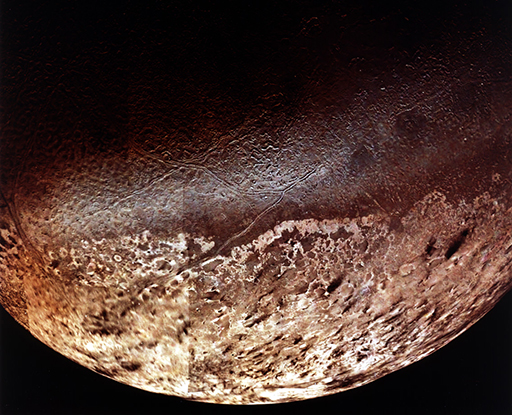1.7 Some other cryovolcanic moons
Cryovolcanism is not restricted to Enceladus. Other icy moons also show evidence of cryovolcanism.
The surface of Ariel (Figure 12) is thought to be the youngest of all of Uranus’ moons, having had the most recent geological activity. While it is unknown if it is currently active, it has been completely resurfaced since the beginning of the Solar System. The deep canyons seen in the image have been filled in and are possibly linear vents. Some similar features occur on Pluto’s largest moon, Charon.
Figure 13 is Inverness Corona. This large corona is interpreted as an enormous cryovolcanic complex. It is one of three cryovolcanic complexes identified on Miranda.
The smooth surface (shown in Figure 14) is thought to be of cryovolcanic origin with mounds and pits formed by ice flows. It has a thin, nitrogen atmosphere that is thought to have been created by the volcanic activity.
Next, try a short activity on some of what you’ve learned so far this week.
Activity 1 Moons volcanism
a.
Radioactive decay from the body’s centre
b.
Tidal heating
c.
Relic heat from the body’s formation
The correct answer is b.
b.
Correct!
a.
Miranda
b.
Ariel
c.
Triton
The correct answer is a.
a.
Correct. Inverness Corona is the chevron-patterned area apparent in most images of Miranda.
a.
3 million years ago
b.
3 billion years ago
c.
3 trillion years ago
The correct answer is b.
b.
Well done.
a.
Sodium
b.
Oxygen
c.
Ammonia
The correct answer is c.
c.
Correct. Ammonia is one of several substances believed to occur within icy moons that could lower the melting temperature of the ice.



